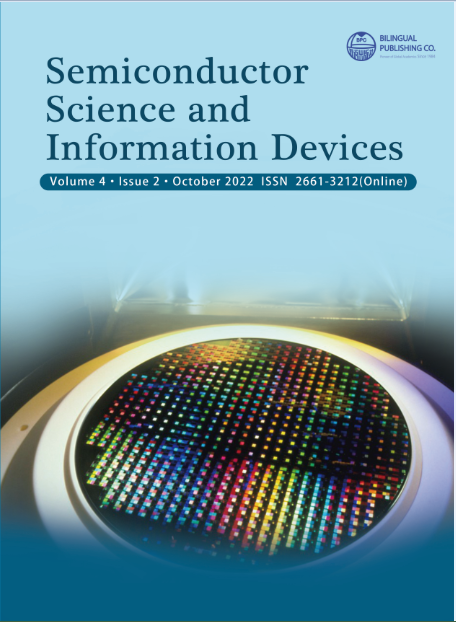Electronic Structure of CdS Nanoparticles and CdSe/CdS Nanosystems
DOI:
https://doi.org/10.30564/ssid.v4i2.4708Abstract
The electronic states of “wurtzite” CdS nanoparticles and CdSe/CdS nanosystems with up to 80 pairs of Cd-Se or CdS atoms were calculated.The results for CdS particles were compared with the results obtained earlier for CdSe particles of the same size and with published calculations of other authors. The calculated gap values in the range of 2.84 eV ~ 3.78 eV are typical for CdS particles of studied sizes in accordance with results of published data. The CdSe/CdS nanosystems were considered as layered ones and as quantum dots. The layered CdSe/CdS systems with twolayer CdS coverings can be interpreted in terms of combinations of two semiconductors with different energy band gaps (2.6 eV and 3.3 eV), while analogous systems with single-layer CdS coverings do not demonstrate a two-gap electron structure. Simulation of a CdSe/CdS quantum dot shows that the single-layer CdS shell demonstrates a tendency for the formation of the electronic structure with two energy gaps: approximately of 2.5 eV and 3.0 eV.
Keywords:
Nanoparticles; Cadmium sulfide; Cadmium selenide; Energy gap; Modeling with pseudopotentialsReferences
[1] Rani, S., Thanka Rajan, S., Shanthi, J., et al., 2015. Review on the materials properties and photoelctrochemical (PEC) solar cells of CdSe, Cd1-xZnxSe, Cd1-xInxSe, thin films. Materials Science Forum. 832, 1-27. DOI: https://doi.org/10.4028/www.scientific.net/MSF.832.1
[2] Rosmani, C.H., Zainurul, A.Z., Rusop, M., et al., 2014. The Optical and Electrical Properties of CdSe Nanoparticles. Advanced Materials Research. 832, 557-561. DOI: https://doi.org/10.4028/www.scientific.net/AMR.832.557
[3] Abbassi, A., Zarhri, Z., Azahaf, Ch., et al., 2015. Boltzmann equations and ab initio calculations: comparative study of cubic and wurtzite CdSe. SpringerPlus. 4, 543. DOI: https://doi.org/10.1186/s40064-015-1321-z
[4] Hu, J.T., Wang, L.W., Li, L.Sh., et al., 2002. Semiempirical Pseudopotential Calculation of Electronic States of CdSe Quantum Rods. The Journal of Physical Chemistry B. 106, 2447-2452. DOI: https://doi.org/10.1021/jp013204q
[5] Proshchenko, V., Dahnovsky, Y., 2014. Spectroscopic and electronic structure properties of CdSe nanocrystals: spheres and cubes. Physical Chemistry Chemical Physics. 16, 7555-7561. DOI: https://doi.org/10.1039/C3CP55314K
[6] S. Neeleshwar, C.L., Chen, C.B., Tsai, Y.Y., et al., 2005. Size-dependent properties of CdSe quantum dots. Physical Review B. 71, 201307(1-4). DOI: https://doi.org/10.1103/PhysRevB.71.201307
[7] Ali, S.K., Wani, H., Upadhyay C., et al., 2020. Synthesis of CdS Nanoparticles by Chemical Co-precipitation Method and its Comparative Analysis of Particle Size via Structural and OpticalCharacterization. Indonesian Physical Review. 3(3), 100-110. DOI: https://doi.org/10.29303/ipr.v3i3.64
[8] Kamble, M.M., Rondiya, S.R., Bade, B.R., et al., 2020. Optical, structural and morphological study of CdS nanoparticles: role of sulfur source. Nanomaterials and Energy. 9(1), 72-81. DOI: https://doi.org/10.1680/jnaen.19.00041
[9] Edossa, T.G., Woldemariam, M.M., 2020. Electronic, structural, and optical properties of zinc blende and wurtzite cadmium sulfide (CdS) using density functional theory. Advances in Condensed Matter Physics. 2020. DOI: https://doi.org/10.1155/2020/4693654
[10] Soltani, N., Gharibshahi, E., Saion, E., 2012. Band gap of cubic and hexagonal CdS quantum dots. Experimental and theoretical studies. Chalcogenide Letters. 9(7), 321-328.
[11] Khan, Z.R., Zulfequar, M., Khan, M.S., 2011. Chemical synthesis of CdS nanoparticles and their optical and dielectric studies. Journal of Materials Science. 46, 5412-5416. DOI: https://doi.org/10.1007/s10853-011-5481-0
[12] Qi, L.M., Cölfen, H., Antonietti, M., 2001. Synthesis and characterization of CdS nanoparticles stabilized by double-hydrophilic block copolymers. Nano Letters. 1(2), 61-65. DOI: https://doi.org/10.1021/nl0055052
[13] Muradov, M., Goncha, E., Bagirov, A., 2007. The effect of solutions concentrations on the optical properties of CdS nanoparticles formed in the polymeric matrix. Journal of Optoelectronics and Advanced Materials. 9(5), 1411-1413.
[14] Thakur, S., Kaur, R., Mandal, S.K., 2021. Size dependence of CdS nanoparticles on the precursor concentration and visible light driven photocatalytic degradation of methylene blue. New Journal of Chemistry. 45(27), 12227-12235. DOI: https://doi.org/10.1039/d1nj01588e
[15] Favero, P.P., de Souza-Parise, M., Fernandez, J.L.R., et al., 2006. Surface Properties of CdS Nanoparticles. Brazilian Journal of Physics. 36(3B), 1032-1034. DOI: https://doi.org/10.1590/S0103-97332006000600062
[16] Zavodinsky, V., Gorkusha, O., Kuz’menko, A., 2022. Total energy and electronic states of CdSe nanoparticles. Semiconductor Science and Information Devices. 4(1). DOI: https://doi.org/10.30564/ssid.v4i1.4420
[17] Berger, L.I., 1997. Semiconductor Materials, CRC Press, New York, NY, USA, 1st edition.
[18] Zhou, W.L., Cai, T., Chen, Y., et al., 2014. Synthesis of CdS-Capped CdSe Nanocrystals without any Poisonous Materials. Advanced Materials Research. 981, 806-809. DOI: https://doi.org/10.4028/www.scientific.net/AMR.981.806
[19] Sarkar, P., Springborg, M., Seifert, G., 2005. A theoretical study of the structural and electronic properties of CdSe/CdS and CdS/CdSe core/shell nanoparticles. Chemical Physics Letters. 405, 103-107. DOI: https://doi.org/10.1016/j.cplett.2005.02.001
[20] Dmitri, V., Talapin, J.H., Nelson, E.V., et al., 2007. Seeded growth of highly luminescent CdSe/CdS nanoheterostructures with rod and tetrapod morphologies. Nanoletters. 7(10), 2951-2959. DOI: https://doi.org/10.1021/nl072003g
[21] Romanova, K.A., Galyametdinov, Y.G., 2021. Quantum-chemical study of CdSe/CdS core/shell and CdSe/CdS/ZnS core/shell/shell quantum dots with different layers ratio. AIP Conference Proceedings 2380, 060001. DOI: https://doi.org/10.1063/5.0058295
[22] Luo, Y., Wang, L.W., 2010. Electronic Structures of the CdSe/CdS Core-Shell Nanorods. ACS Nano. 4(1), 91-98. DOI: https://doi.org/10.1021/nn9010279
[23] Beckstedte, M., Kley, A., Neugebauer, J., et al., 1997. Density functional theory calculations for poly-atomic systems: electronic structure, static and elastic properties and ab initio molecular dynamic. Computer Physics Communications. 107, 187-205. DOI: https://doi.org/10.1016/S0010-4655(97)00117-3
[24] Kohn, W., Sham, J.L., 1965. Self-consistent equations including exchange and correlation effects. Physical Review. 140, A1133-A1138. DOI: https://doi.org/10.1103/PhysRev.140.A1133
[25] Fuchs, M., Scheffler, M., 1999. Ab initio pseudopotentials for electronic structure calculations of poly-atomic systems using density functional theory. Computer Physics Communications. 119, 67-165. DOI: https://doi.org/10.1016/S0010-4655(98)00201-X
[26] Perdew, J.P., Wang, Y., 1986. Accurate and simple density functional for the electronic exchange energy. Physical Review B. 33, 8800-8802. DOI: https://doi.org/10.1103/PhysRevB.33.8800
[27] Ceperly, D.M., Alder, B.J., 1980. Ground state of the electron gas by a stochastic method. Physical Review Letters. 45, 566-569. DOI: https://doi.org/10.1103/PhysRevLett.45.566
[28] Troullier, N., Martins, J.I., 1991. Efficient pseudopotentials for plane-wave calculations. Physical Review B. 43, 1993-2006. DOI: https://doi.org/10.1103/PhysRevB.43.1993
Downloads
How to Cite
Issue
Article Type
License
Copyright © 2022 V. Zavodinsky, O. Gorkusha, A. Kuz’menko

This is an open access article under the Creative Commons Attribution-NonCommercial 4.0 International (CC BY-NC 4.0) License.




 Aims and Scope
Aims and Scope V. Zavodinsky
V. Zavodinsky





